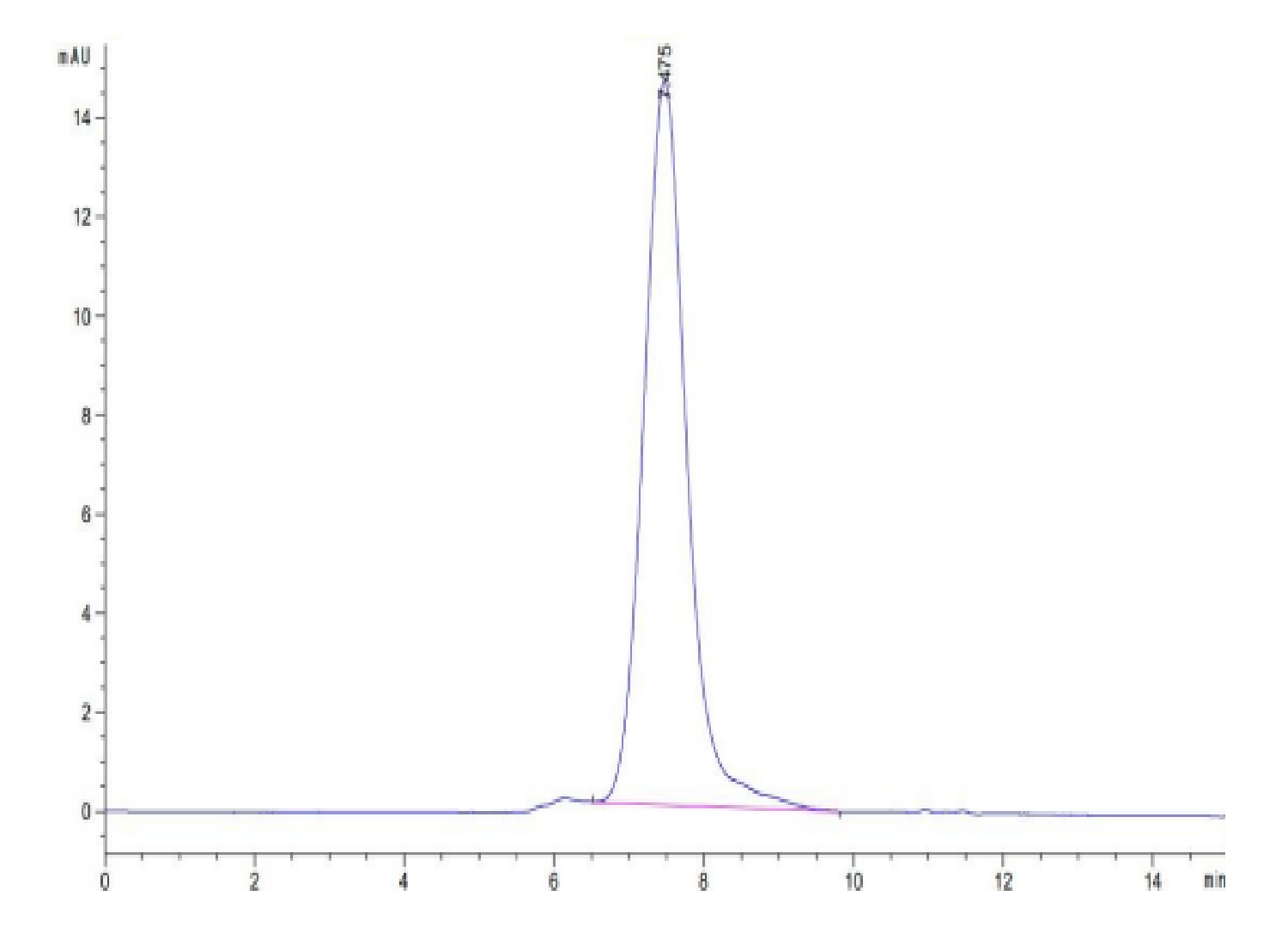| Weight | 1 lbs |
|---|---|
| Dimensions | 9 × 5 × 2 in |
| accession | Q96D42 |
| express system | HEK293 |
| product tag | C-His |
| purity | > 95% as determined by Tris-Bis PAGE;> 95% as determined by HPLC |
| background | Kidney injury molecule 1 (KIM-1, also known as TIM-1) is markedly upregulated in the proximal tubule after injury and is maladaptive when chronically expressed. KIM-1-mediated epithelial cell phagocytosis of apoptotic cells protects the kidney after acute injury by downregulating innate immunity and inflammation. |
| molecular weight | The protein has a predicted MW of 30.58 kDa. Due to glycosylation, the protein migrates to 95-115 kDa based on Tris-Bis PAGE result. |
| available size | 100 µg, 500 µg |
| endotoxin | Less than 1EU per μg by the LAL method. |
Human TIM-1/HAVCR1 Protein 2781
$315.00 – $1,050.00
Summary
- Expression: HEK293
- Pure: Yes (HPLC)
- Amino Acid Range: Ser21-Gly295
Human TIM-1/HAVCR1 Protein 2781
| protein |
|---|
| Size and concentration 100, 500µg and lyophilized |
| Form Lyophilized |
| Storage Instructions Valid for 12 months from date of receipt when stored at -80°C. Recommend to aliquot the protein into smaller quantities for optimal storage. Please minimize freeze-thaw cycles. |
| Storage buffer Shipped at ambient temperature. |
| Purity > 95% as determined by Tris-Bis PAGE |
| target relevance |
|---|
| Kidney injury molecule 1 (KIM-1, also known as TIM-1) is markedly upregulated in the proximal tubule after injury and is maladaptive when chronically expressed. KIM-1-mediated epithelial cell phagocytosis of apoptotic cells protects the kidney after acute injury by downregulating innate immunity and inflammation. |
| Protein names Hepatitis A virus cellular receptor 1 (HAVcr-1) (Kidney injury molecule 1) (KIM-1) (T-cell immunoglobulin and mucin domain-containing protein 1) (TIMD-1) (T-cell immunoglobulin mucin receptor 1) (TIM) (TIM-1) (T-cell membrane protein 1) (CD antigen CD365) |
| Gene names HAVCR1,HAVCR1 KIM1 TIM1 TIMD1 |
| Protein family Immunoglobulin superfamily, TIM family |
| Mass 9606Da |
| Function Phosphatidylserine receptor that plays an important functional role in regulatory B-cells homeostasis including generation, expansion and suppressor functions (By similarity). As P-selectin/SELPLG ligand, plays a specialized role in activated but not naive T-cell trafficking during inflammatory responses (PubMed:24703780). Controls thereby T-cell accumulation in the inflamed central nervous system (CNS) and the induction of autoimmune disease (PubMed:24703780). Regulates also expression of various anti-inflammatory cytokines and co-inhibitory ligands including IL10 (By similarity). Acts as a regulator of T-cell proliferation (By similarity). May play a role in kidney injury and repair (PubMed:17471468).; (Microbial infection) Acts as a receptor for Hepatitis A virus.; (Microbial infection) Acts as a receptor for Ebolavirus and Marburg virus by binding exposed phosphatidyl-serine at the surface of virion membrane (PubMed:21536871). Serves as a dual receptor for Ebolavirus by also interacting with envelope glycoprotein GP (PubMed:26487564).; (Microbial infection) Acts as a receptor for Dengue virus by binding exposed phosphatidyl-serine at the surface of virion membrane (PubMed:23084921). TIM1 and Dengue virus are co-internalized during virus entry (PubMed:29742433).; (Microbial infection) Acts as a receptor for Zika virus by binding to envelope protein E.; (Microbial infection) Plays a positive role in Chikungunya virus cell entry. |
| Subellular location Cell membrane ; Single-pass type I membrane protein . |
| Tissues Widely expressed, with highest levels in kidney and testis. Expressed by activated CD4+ T-cells during the development of helper T-cells responses. |
| Structure Interacts with STAM (PubMed:29742433). Interacts with SELPLG (PubMed:24703780).; (Microbial infection) Interacts with hepatitis A virus capsid proteins.; (Microbial infection) Interacts with Ebolavirus envelope glycoprotein GP.; (Microbial infection) Interacts with Zika virus envelope protein E. |
| Post-translational modification Ubiquitinated at two lysine residues Lys-338 and Lys-346 on its cytoplasmic domain. Ubiquitination promotes receptor endocytosis and target receptors for lysosomal degradation and termination of receptor signaling.; (Microbial infection) Ubiquitination is required for Dengue virus endocytosis. |
| Target Relevance information above includes information from UniProt accession: Q96D42 |
| The UniProt Consortium |
Data
 |
| The purity of Human TIM-1 is greater than 95% as determined by SEC-HPLC. |
 |
| Human TIM-1 on Tris-Bis PAGE under reduced condition. The purity is greater than 95%. |
Publications
Publications
| pmid | title | authors | citation |
|---|---|---|---|
| We haven't added any publications to our database yet. | |||
Protocols
| relevant to this product |
|---|
Documents
| # | ||
|---|---|---|
| Please enter your product and batch number here to retrieve product datasheet, SDS, and QC information. | ||














